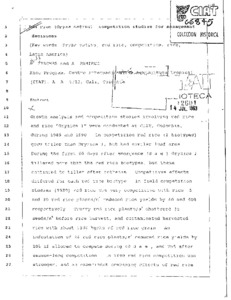Red rice (oryza sativa): competition studies for management decisions
Growth analysis and competition studies involving red rice and rice "Oryzica 1" were conducted at CIAT, Colombia, during 1989 and 1990. In competition red rice (2 biotypes) grew taller than Oryzica 1, but had similar leaf area. During the first 60 days after emergence (d.a.e.) Oryzica 1 tillered more than the red rice biotypes, but these continued to tiller after anthesis. Competitive effects differed for each red rice biotype. In field competition studies (1989) red rice was very competitive with rice: 5 and 20 red rice plants/m2 reduced rice yields by 40 and 60 respectively. Twenty red rice plants/m2 shattered 35 seeds/m2 before rice harvest, and contaminated harvested rice with about 1100 kg/ha of red rice grain. An infestation of 24 red rice plants/m2 reduced rice yields by 10 if allowed to compete during 40 d.a.e., and 75 after season-long competition. In 1990 red rice competition was stronger, and an experiment combining effects of red rice density and duration of competition indicated that 50 yield was lost when 24 red rice plants/m2 competed during 40 d.a.e. with Oryzica 1. Economic analysis using competition data indicated that with current prices in Colombia and given the high red rice competitiveness, herbicide control with glyphosate (2 kg ai/ha) followed by paraquat (0.75kg ia/ha) was economically justified even at very low red rice densities. The probability of justifying hand weeding practices was higher among low-yield-farmers, early weeding, and low labour costs.

